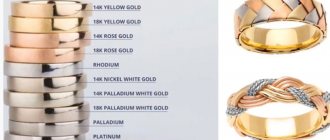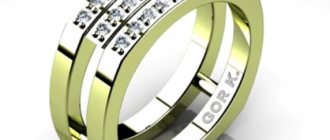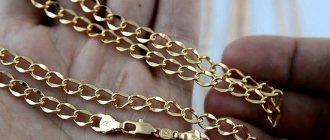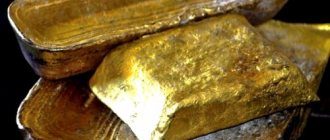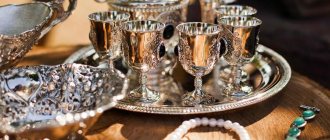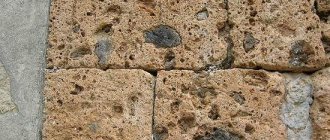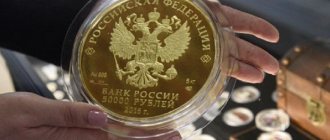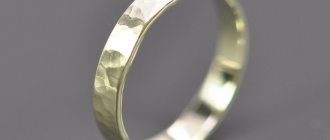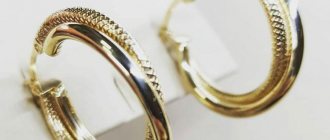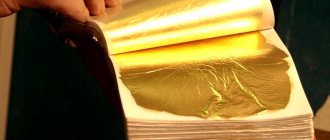Post updated: May 25, 2020
Gold leaf is the thinnest sheets of precious metal up to a fraction of a micron thick. This unusual material is used for gilding jewelry and other products, the production of which involves coating with tinsel. The sheets are made either of pure yellow metal or of its alloys with silver or copper. The physical properties of gold allow the minimum thickness of leaf plates to be achieved - pure metal is soft and malleable. The simplest example of objects covered with tinsel is the domes of churches, which for several centuries have traditionally been finished with sheets of the thinnest sheets of precious metal. How do modern craftsmen do gilding with gold leaf?
Fields of application of gilding
Gilding is used in many areas of our lives - it is performed for protective, decorative, protective and decorative purposes. In particular, plating with 18 and 24 carat gold allows you to give a status look to jewelry made from silver or metal alloys, and also helps restore the beauty of gold items that have lost their original appeal.
Gilding of decor and household items improves the interior of apartments and houses - door handles, forks and spoons, taps, picture frames, metal parts of lamps, etc. are subjected to the procedure.
There is an increasing interest in gilding moldings, chrome inserts, car grilles, handles, and key rings. Plating discs with 24 carat gold, 18Kt/750, 14Kt/585 is practiced.
White, pink, and green gold plating is used in musical instruments, awards, and sports accessories. The gilding of engravings, cigarette cases, lighters, flasks, weapon parts, etc. deserves special attention.
The thinnest layer of gold is sprayed onto car, window and stained glass glass to control heat transfer in winter and summer. Gilding is used in dentistry. It is widely used in microelectronics.
The technology involves the following main steps:
- choosing a gilding method and preparing everything necessary for its implementation;
- degreasing and surface etching;
- coating;
- finishing treatment.
In addition to sputtering the noble metal in its pure form (24 carats, 999 standard), plating with yellow, white, pink, red and green gold is practiced. The alloying additives used are cobalt, rhodium, copper, and silver (nickel). Instead of 24-karat metal, it is plated with gold of 18, 14, 12, 10, 9, 8 carats - the number means the weight units of pure gold in 24 parts of the alloy.
Production of tinsel
The softness and malleability of pure gold allows the metal to be rolled into very thin sheets. Thanks to these physical properties of the metal, the sheets are obtained without cracks and breaks, that is, they are not damaged during the manufacturing process. The process of producing gold sheets begins with the casting of a bar. An ingot with dimensions of 20x5x1 cm is cast from metal, and then carefully rolled into a strip. The length of such a strip can reach 30 meters.
How to continue working with gold leaf? The strip is cut into squares, which are folded together, separated by paper sheets. Before the tinsel can be used for gilding work, this book is sent under a hammer that works about two thousand blows. Under the blows of the instrument, the sheets of tinsel become even thinner and form a kind of “cake”. A square is cut out of the “cake” and placed in a book.
The most important stage in the production of tinsel is beating the gold with a hammer. This procedure is very labor-intensive and difficult to perform. The hammer must strike so that the blows occur not only in a certain sequence, but also with the same force. Compliance with these requirements is mandatory, as it ensures the same thickness of the gold sheets over their entire area.
One book contains up to three hundred leaf sheets, each of which becomes 10 times larger after the beating procedure. For the most complete picture of the tinsel production process, it is recommended to watch the video, which reflects each stage of the production of thin gold sheets. Working with gold leaf largely depends on the quality of the sheets. If the sheets are made in accordance with all the rules, then the gilding of the product will also meet all quality requirements.
Technology of coating objects with gold leaf
Gold coating of plastic, wood, metal and other materials is carried out using the thinnest sheets - the thickness of gold leaf (cladding) is 0.13-0.67 microns. In the old days, gold leaf was made by hand, today special equipment is used. Depending on the thickness of the sheet, free and transfer (on silk paper) gold leaf is distinguished. It is very difficult to work with the first one - the slightest breath interferes with the process. The finished material is stored in little books - each of the 60 sheets is covered with paper. Applying gold leaf is a painstaking process. The technology is based on the ability of gold rolled out from a sheet to be attracted to the surface at the molecular level. There are two techniques for gilding with gold leaf: glue (for polyment) and oil (for Mordan varnish). In the first case, a glossy surface is obtained, and in the second, a matte surface. The adhesive method is used when carrying out interior work.
Types of silver plating
There are also many options for silvering itself. The most popular is galvanic. This coating technology is carried out by electrolytic deposition. In jewelry, electroplating silver plating is used for the following purposes:
- decoration;
- reliable protection.
For electrolysis, electrolytes based on cyanide complexes are used. This silver cyanide increases the conductivity of the electrolyte.
Another option is chemical silvering without the use of current. This procedure is based on the recovery of silver from solutions of its complex salts. These solutions contain complex silver ions and a special reducing agent.
Electroplating
The galvanic gilding process is the most commonly used process today. It is applicable when processing conductive products is carried out. The electrolyte becomes a solution of gold salts. A part is immersed in it - when a current passes, positively charged particles released from metal salts settle on the surface of the product and form an even layer of gold.
An even better result can be obtained using the selective method of electrochemical gilding. The use of this technique makes it possible to increase the rate of metal deposition on the product tens of times. The wear resistance and hardness of gold coating increases by more than 3 times. Gold penetration occurs at the molecular level. Electroplating methods are used in gilding souvenirs, jewelry, dentures, etc.
Restoration of gilding on wood
Gilded wood, ancient or not, can be restored in various ways, often traditional, but quite affordable. And step by step, faded gilded sculptures, picture frames, carvings on furniture will regain their former shine.
Gold leaf gives objects a magnificent appearance, but does not have the best effect on their strength - the surface becomes quite fragile. These days, gold is most often used to cover frames, but it looks great on a variety of items: moldings and sculpture, metal or porcelain, and even furniture. In this article we will talk about the restoration of gilded wood only, since it is the most labor-intensive.
Before starting restoration work, you should determine its scope and make sure it is necessary. A good cleaning sometimes gives better results than applying a thick layer of imitation gold varnish.
In the 17th and 18th centuries. gold leaf was applied to the wood carvings over a primer. For reasons of economy, since the 19th century. and to this day gold covers the hardened, cast mass glued to a wooden base. Over time, as a result of deformation of the wood or aging of the mass, its gilded fragments begin to crumble. The only way out is to replace the lost areas. A cast of surviving elements can be made either with a traditional composition consisting of chalk, carpentry or bone (or better yet, fish) glue and white, or with more modern special synthetic compositions (for example, from Dugform or Darwi).
| The basis of all preparatory operations, carpentry, bone or fish glue, is sold in plates or powder. In the first case, the glue, cut into small pieces, must be soaked in cold water for at least 12 hours. Powdered glue does not need to be soaked. Water is heated in a water bath and mixed with glue at a ratio of 1:7. | |
| Care should be taken when cleaning gold-plated surfaces. It is not advisable to use old recipes, such as egg white mixed with oxalic acid, or potatoes, because in the first case, a layer of gilding can be removed, and in the second, particles can get stuck in the cracks of the base, which will subsequently become moldy. It is better to clean the surface with a piece of cotton wool moistened with special cleaning agents, for example a solution of alcohol with N4 thinner (pinene). To avoid mold, add a little formaldehyde. | |
| To replace a missing thread element, start by making a plastic cast of it, selecting an identical preserved section. | |
| Before pouring synthetic resin (Vixint or Formoplast) into the cast, lubricate it with Vaseline. The resin is very plastic, so it will accurately follow all the lines of the relief. | |
| After the resin has hardened, carefully remove the mold and, having greased it with oil, fill it to the brim (but not overfilling) with a mixture of plaster or chalk with PVA glue or ready-made Dugform composition. | |
| After drying, remove the element from the mold, smooth out any irregularities and adjust it into place using a file. Plaster and PVA casts are quite fragile and therefore require delicate handling, while Dugform, once cured, becomes porcelain-like and more durable. Gluing is done with heated carpentry, bone or fish glue with the addition of a small amount of white. | |
| Red primer (polyment) is applied in 2-3 layers and clogs the pores of the base before covering it with gilded wax. | |
| After drying, the wax is polished with a soft cloth. Since wax has a bad habit of oxidizing over time, it should only be used for retouching on the least valuable objects. | |
| In case of minor losses of the ornament, the cast can be made from mold plastic. Soften it in your hands and apply it to the whole fragment. Leave it to harden a little. | |
| To obtain putty, mix dry lead or titanium white with heated glue in a vessel until a thick mass is obtained, add a little drying oil. Knead the resulting mass thoroughly with your hands. | |
| Leave the putty wrapped in a damp cloth and a plastic bag for 5 hours to ensure it is completely homogeneous. It is equally well suited for both making a cast and gluing it, as well as for forming an ornament. | |
| Putty has many advantages. When the impression is still soft, it can be removed from the mold without damage and easily inserted into the desired location. | |
| Small voids in the area of the broken ornament do not need to be filled with casts; they can simply be sealed with putty or formoplast. Before applying gold primer, cover these fragments several times with a liquid primer prepared from fish or wood glue heated in a water bath and dry whitewash. After each layer has dried, carefully sand the surface. |
Gold leaf coating
Applying gold leaf to the surface is an ancient technique, reinforced by centuries of experience, which requires as much skill as patience, because before you start gluing gold leaves, you need to consistently perform about fifteen preparatory operations. The quality and tightness of the gold leaves will depend on the careful implementation of these processes.
After degreasing the wood and applying the first layer of glue, apply several layers of primer (chalk, fish glue and a little linseed oil) alternately with drying and fine sanding. Then you need to put 6-8 layers of white. To ensure the surface remains smooth, it must be dried quickly. Gold-tinted primer completes the preparation of the base.
The gold leaf sheets obtained by rolling have a thickness of 4 to 8 microns, which allows them to fit tightly to the smallest surface details.
| Sheets of gold leaf are sold in the form of a book. Under no circumstances should they be touched with hands. Blowing from above, place the sheet on a special pad and smooth it flat with a special semicircular spatula. Then cut into small squares. To glue them, you need to slightly moisten the soil with a solution for gluing gold plates (3 volumes of water per 1 volume of bone glue). | |
| Carrying the gold leaf will require a small charge of static electricity. To do this, take a special brush in the form of a spatula made of squirrel fur (you can use a regular flat squirrel watercolor brush) and rub it on your cheek or hair. The attraction of the primed surface is so strong that the leaves magnetized with a brush should take the right place the first time. | |
| Smooth the sheet with a dry squirrel brush with a flat end and varying lengths of bristles. Remove excess adhesive solution with a cotton swab, but do not rub it on the gold. | |
| Wait 3-4 hours until the soil has completely dried, and then with an agate polisher (in the old days they used a ring with agate), lightly pressing, polish the gold on the protruding parts, the shine of which will contrast with the matte tint in the recesses. Secure the coating with gilding glue, which is applied from right to left in the direction the sheets are laid on top of each other. | |
| Gold is patinated with gouache paints or tempera. The shade should be light enough to unify and shade the polished areas. Apply a little paint with a wide brush and remove any excess. Then secure the tint with a rag rubbed on a block of clean wax. |
Practical advice
On furniture and wooden products with gilding, small pieces may break off and fall off as a result of deformation of the wood or during assembly. This occurs much more often than damage to the wooden base. On sale you can find products for the care and repair of surfaces coated with gold leaf: various varnishes, mastics, wax in bars. Even if a very small area of the surface needs repair, the work should begin with a gentle but thorough cleaning of the entire product. Small defects can be quite successfully repaired with a special pencil that imitates gold plating, drawing it perpendicular to the scratches. These tools allow for minor retouching, but not serious expensive restoration.
| Gold plating wax comes in a variety of shades. It is applied with a brush (usually after applying a layer of primer). | |
| A red ocher primer applied as a bottom layer gives the restored fragment its original appearance. After the wax has dried, polish the surface with a soft cloth. | |
| Instead of wax, you can use very easy-to-use gilding varnishes. When used for decorative purposes, they can work real miracles. After degreasing the surface, apply the varnish with a brush and allow it to dry. | |
| To quickly restore a small chipped fragment, you can use gilding mastic. Take a small piece of it with your fingers and soften it. Fashion the missing part and place it in the right place. Mastic, like wax, can be polished. |
The editors would like to thank Maya Aleksandrovna Strizhenova, the head of the department for the restoration of museum valuables at the State Unitary Enterprise "CENTRRESTAURATSIYA", for her advice.
Immersion gilding technique
This type of gilding does not involve the application of external current. When a part is immersed in a solution of a less electronegative metal, the process of immersion deposition occurs. Once the contact exchange ends, it ends. The technology includes several stages - work begins with acidic surface cleaning and micro-etching, and ends with chemical deposition of a nickel layer and subsequent application of immersion gold. The technology is used in the production of printed circuit boards, component terminals, housings, microcircuits and other products that require ultrasonic welding or soldering.
Some tips
In fact, the silvering process is not as simple as it might seem at the very beginning. The procedure has a number of features that must be taken into account when performing, they are as follows:
- Most often, copper, brass or aluminum objects and products are subjected to the silvering procedure. During processing, these alloys, interacting with the solution, create a reaction, as a result of which they begin to release metallic silver. This is what allows this technological process to take place.
- The easiest way to coat light metal surfaces with silver. If products made of dark metal are used, then it is necessary to apply a layer at least 10-15 micrometers thick, otherwise the dark surface will show through and spoil the appearance.
- During the procedure, regardless of where it is carried out - at home or in a production facility, it is necessary to ensure good ventilation.
- To achieve a higher quality silver coating, you need to thoroughly clean and degrease the surface to be treated.
- It is advisable to apply special pastes that are used for silvering metal with a soft cloth or a small piece of leather.
These are the main methods of silver plating that can be used in an apartment. It’s quite possible to make them yourself, and the ingredients used for production are sold in the public domain.
Methods of chemical gilding
At home, gilding of decor, gold coating of spoons, decorative flowers and other metal objects is carried out by rubbing their surface with gold chloride paste or immersing them in a solution with a zinc contact. In the first case, gold is dissolved in a mixture of nitric and hydrochloric acids (1:3). The ratio of gold and solution is 1g/10 ml. The liquid is evaporated, observing safety precautions. The resulting gold chloride is combined with melted (extracted) chalk, cream of tartar and blood salt. After applying the paste with a brush, the object is left for a certain time. It is then washed and polished. By mixing gold chloride with ether, patterns and inscriptions are made.
To prepare a solution for gilding from gold chloride, distilled water (its temperature should be about 50-60 degrees), potash and salt are combined with it. A degreased, acid-etched and water-washed object is immersed in the solution and touched with a zinc stick. Once the gold deposition process is complete, the item is washed and polished. To delve into the details of the technology, it is worth watching a master class on gilding.
What it is?
Leaf is a metal sheet of silver that is very thin. It consists of silver (natural or pure), which exhibits the property of being alloyed with other types of materials.
Often, leaf is a metal with the highest purity, which performs a number of important functions:
- protective. Gold and silver leaf acts as a reliable protection for the base from the effects of negative factors in the atmosphere;
- anti-corrosion. This type of coating prevents the risk of rust on the base of the product;
- decorating (aesthetic). The material should be applied to objects, as it gives the base higher aesthetic qualities. Look at the following photo to see for yourself how attractive a pendant with silver leaf, decorated using the lampwork technique, looks.
To work with such material, you need to have certain skills.
Pencil gilding
Another “home” method is to use a galvanic pencil in which the tip serves as the anode and the surface of the product as the cathode. The principle of deposition is similar to the electroplating method, but the equipment used eliminates the use of a solution bath.
Noble metal not only decorates products, but also performs protective functions. The gilding process should be entrusted to professionals - lack of experience and the use of dangerous components often leads to undesirable consequences.
Prevention and care rules
The gold plating wears off over time. Constant use leads to a gradual thinning of the spray layer. By following some recommendations you can extend the service life. Rules for caring for gold-plated products:
- Regularly polish cutlery and decorations using a suede cloth.
- Minimize contact with water, perfume and body creams.
- Place each product separately, so that they do not touch each other. After each use of jewelry, put it back in place. Distribute each decoration into separate suede bags, and cutlery into special boxes.
Clean regularly, regardless of whether the product has lost its attractive appearance or not.
Finishing of silver-plated products
To protect silver coatings from oxidation under the influence of oxygen and the formation of sulfur compounds, a passivation process is carried out. For chemical passivation, the products are placed in a 1% solution of chromium for 20 minutes.
Blackening of silver (processing on old silver) is carried out in a solution of sulfur liver, which is fused with patasha 1 to 2 and dissolved in warm water in an amount of 20-30 g/l. The solution is heated to 60-700C and pre-degreased products are immersed in it (it is possible to apply the solution with a brush), then the products are brushed with brass brushes.
Source
